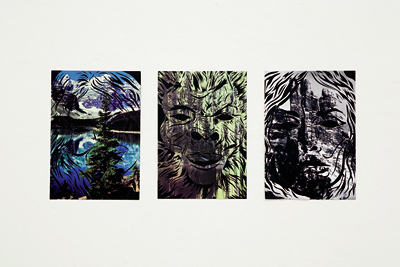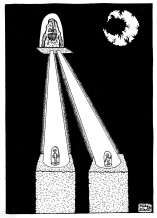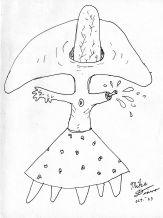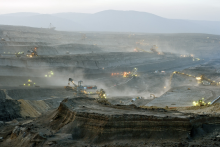| Umělec magazine 2009/2 >> Ben Cottrell, Jana Kochánková und Vladimír Skrepl / Lost Eye / MeetFactory Gallery / 2009 | List of all editions. | ||||||||||||
|
|||||||||||||
Ben Cottrell, Jana Kochánková und Vladimír Skrepl / Lost Eye / MeetFactory Gallery / 2009Umělec magazine 2009/201.02.2009 Katarína Uhlířová | review | en cs de |
|||||||||||||
|
The shattered reality of Ben Cottrell from Cornwall and Berlin
The first thing I noticed about the Lost Eye1 exhibition were the drawings. They were new to me, all of them from the two-month period when Ben Cottrell (born 1982 in Cornwall) was a resident of MeetFactory in Smíchov. Drawings of faces and grimaces. Collages of decaying smiles. Masks with wrinkles of reality. The many smaller drawings lined up to form entire compositions. A mozaic, like the compound eye of a dragonfly. Or some other eye? Perhaps like a plastic kaleidoscope that’s just been smashed in front of you with a hammer. In one moment, we can see the kaleidoscope’s intestines and stomach and heart. Colorful, irregular shards and broken mirrors. Just a moment ago there were neat and wildly colorful flowers or elegant and lively arabesques visible in it. All we had to do was endlessly turn the kaleidoscope. Anyone can turn it. Few can take up the hammer. Ben Cottrell doesn’t just compose and turn: as long as he’s using the additive principle, he’ll take a composition and break it, cut it up, tear it apart, shatter it. He breaks reality. He wants to see through it, to the other side, and peek outside of it. With his work, Ben is seeking out the decoratively cacophonic. As if some fragmentary potential were present in everything he sees and everyone he meets. Even the places that Ben inhabits or frequents are riddled with cracks that the unreal, submerged, and silenced creep into. The strange. Even the unwanted. Through these cracks, via Ben’s images, the mythical snake is crawling into our reality. The altar of this strangeness is formed by Ben’s three-dimensional construction. Drawings with cracks in them are nothing new, and neither is their altered hyper-reality. You like 3-D cracks? Here they are. Rendered in carved particleboard and plywood, on a pedestal of recycled furniture, and crowned with a violently punctured head. The intersection of nature and un-nature – the cultural. WIlderness. Ben’s collages exude an air of something strangely domesticated; perhaps they remind me of wood-colored wallpaper torn from a formica core. Maybe it’s the color of the veneer or earthy color of the dye. The air is even a little dangerous. The unconscious screams. Dark, like a game from a second-rate horror flick applied to real life. Landscapes torn out from a darker imagination. Ben’s paintings pretty much give everyone a headache. There’s something swirling in them. The images are sometimes impossible to look at, which is exactly why I don’t look away. They demand too much attention, but it’s impossible to give as much as they need. The paintings are Ben’s game with darkness and total light. Alice has long ago grown up and the looking-glass is broken; so, let’s watch the reflections. “What now?” Ben asks himself, and we ask ourselves. Ben Cottrell lives and works in Berlin, where he enjoys the local pace of life as well as the diverse cultures and subcultures, jaggedly rooted in both West and East. I love you too! Jana “Koko” Kochánková’s gently colorful environment Jana “Koko” Kochánková (born 1979 in Prague) graduated from a program of Studio Drawing II at Prague’s Academy of Visual Art (AVU), but for me she’s always been, above all, a sculptor of small, delicate plaster still lifes, daring stuff-animal totems – fetishes, covered in plaster. As is well known, Jana, in her role as an American sculptress, uses the stage name Koko. She’s also something of a builder, spryly assembling frail structures, perhaps shelters, of all sizes. Whether she’s building artistic snowmen or artistic igloos or assorted bunkers from clothes and old rags, she always carefully considers the the design of the newly-formed object. Wrapping up skeletons and corpses in fabric, she turns them into sculptures. These transformed bodies will then be further embellished, just as she collects embellishments in her structures. Koko pays special attention to her work-space when she enters it for the first time, and likewise carefully tends to the space that her work creates. The whole work’s stability must be balanced by the weak, soft, and subversive. If Ben Cottrell intentionally smashes and disfigures and his compositions, Jana Kochánková pieces them together, mixing in little surprises, throwing in new layers, or disguising and softening them. Nothing is off-limits. Her last structure, given the working title Kokoland II, gradually transformed into an enormous cake (made by an amorous baker) called I love you too! The apparently shaky construction of the piece, recycled from the styrofoam igloo from Gallery Jelení, was covered in plaster and then dyed. The colors, originally saturated, after being added to the plaster took on a softer, milky, or rather creamy color. Koko finished off the cake, not with almonds or candied fruits, but with a plaster stork, colorful balloons, small trees, and an inverse mushroom-colored polka-dotted shirt, then she added a chair, a flower pot, a striped sweater and a pop-art trampoline. And she topped it all off with a glowing neon light bulb. If I were a map-maker and had to make a map of far-off Kokoland, I’d let it be known that the border of Kokoland is made up of lots of islands and tiny archipelagos. Until you go there, you’ll never guess if they’re islands or just icebergs. One of them is the I love you too! island. The erstwhile, slowly fading installations Iglú (2007) and Bunkr (2007) used to be independent islands. The history of Kokoland, of course, dates back to the author’s first visit to Coney Island or the time she installed her moving statues on New York’s Astor Place. Yes, Koko is a truly American sculptress. The wild images of Vladimír Skrepl Paint. Paste. And the characters’ delightful wildness. At the opening, I watch as people again and again feel the need to touch the paste, to make sure if it’s still soft or if it’s hardened, as if they couldn’t believe their own eyes. Or maybe they’re trying to push, literally shove, the people, monsters, shadows, and happy critters back into the irregular surface of Vladimír Skrepl (born 1955 in Jihlava)’s images. Quick drawings, paintings come to life, zombies of art. Everything is piled up and smeared around until it turns gray. Forgotten. Rediscovered. Is. Image. Repeating again and again. So. Obsessive. A different expression every time. Shouting. Or. Quiet and translucent. Are. These. Gentle. Wild. Beings. Vladimír feels no shame for any color, shape, organ, or word. He signs his work clearly and legibly, proudly, like a happy child. He forms a part of his images. Vladimír might have a problem with the snake of reality, but really, who doesn’t? He’s always fighting the snake. With sincere curiosity and surprise, he catches himself doing something with someone. The images in the exhibition at the MeetFactory gallery are unrestrained, cheerful. Reflections of the unknown and unnameable. They were made in the last year. With hyperbole and humility. Everything has its tongue expressively planted in the cheek of a curious princess. Motion and paralysis. Work and play without needless self-censorship. I, like Vladimír, believe that fear of rigidity, moderation and self-control can be worse than any horror film. His pictures-gestures set us free. Fully aware, or perhaps not, other, similar images can also be experienced. Vladimír both experiences them and paints them. While words, figures, and situations pull him along. Doubts, guesses, wishes, second- and third-rate horror movies and kilometers of supersonic sounds. Pack of dogs, squirrels, and kittens. Even the barking deer of Barrandov waits to be discovered. Vladimír Skrepl, the introverted extrovert in the striped sweater and cap, can do drawing and paintings, open or closed, but mainly, cheerful paintings. He smears and smudges paints like nobody’s business, until they become muddy grays, browns and a weird purple, just so it will bounce off a pure color, clean like a short tune or three clear notes after prolonged noise. The pure colors reflect. They’re reflected by the extroverted introvert in stripes and a cap, who makes wild paintings that are always a joy to witness. “Shit. Squirrel. The snake of reality. Darkness. Princess. Men and women with weapons. Dwarf.” “Those are the words that are running through our heads, they’re like gestures. When you speak, you don’t remember the gestures. Like bisexuality? It’s not so simple. It’s not just animus or just anima, nor just the inner man or aggressive woman. It’s not just a dream about being a hermaphrodite. It’s much more complicated.” Skrepl’s paintings and drawings are gestures that we don’t remember. Everything is much more complicated than we’re willing to admit. And would we even want to know it? To see it, I hope so. Isn’t it sometimes enough to just see a cobra with a mamba in its teeth? A gorgeous woman with a man’s organs? A male goldilocks? Ask yourselves: Where did all these wild princesses come from? And what about the animals? “As words disappear, so too do the bodies. It’s the disappearance of clarity.”2 Bodies reveal themselves in other places. Again. What’s forcing us to perceive the remains of the beautiful human bodies and beautiful wild, or imaginary, animals? Where did all those rare turquoise Mon-Chee-Chees get to, and where did the wolves come from? Cobrablood as a confusing metaphor for the exhibit Showing up at MeetFactory’s first January exhibit and looking at everything on display was like examining, first from a distance and then up close, a bottle of cobrablood. Creating the exhibition must have been similar to drinking the cobrablood. Downing two or even four shots and then, on a whim, having something healthy to eat. Actually, maybe there were five shots. Is cobrablood even medicinal? What is cobrablood? I’d rather not say, but you wouldn't understand the metaphor if I don’t explain. So, what is cobrablood? Cobrablood is an oriental beverage. Maybe it's mysterious to us. There’s undoubtedly some kind of ancient myth behind its creation, but we don’t know it. We just have an idea who to ask or where to start looking. cobrablood is quote, a smooth oriental liquor, unquote, which means that in pure alcohol, or, even better, in some higher-grade booze, there’s a floating, pickled cobra, holding a mamba in its teeth. Vladimír would also like to mention that it’s really holding a tiny mamba in its gaping maw. So, the cobra is holding a mamba, a tiny one, if you like, and floating around this expressive snake sculpture is ginseng. An intense image. Our understanding of what is actually going on inside the bottle, however, is ruined by the decorative, curved shape of the glass bottle. The rounded surface is segmented into several panels whose intersections scatter the light in the different directions, making it look as if the snakes were moving and the ginseng were calmly drifting around them. And so both the snakes and the ginseng will remain, as least until we break the bottle, thus causing the cobrablood to pour out. The exhibition that I should be trying to write about has an impact as strong as cobrablood. The first thing that occurred to me was whether it was beautiful or real. I was struck by a powerful energy that multiplied and then dissipated. For a moment, the symbiosis of Vladimír’s figures, Jana’s art-space, and a strange spider bundled in sugar, and then acophony. Thanks to Ben, there was a whirlwind of coordination at MeetFactory. The large, secluded space, curated by Zuzana Blochová, was fortunate enough to host a cooperative exhibition with Ben Cottrell, Vladimír Skrepl and Jana “Koko” Kochánková. This is what I call a good thing. All three artists are responsible for vital and valuable works of creativity. That January, I saw an exhibition that astonished me; I take it as a challenge. It’s time to head off to Berlin again, for more exhibitions and concerts. 1 The exhibition’s title, Lost Eye, is a reference to the legend of the northern pagan god Odin, who traded his left eye for all knowledge available at the time. The title is supposed to emphasize the intense and wild visual component of the works on display, as well as the fact that Cottrell, Kochánková, and Skrepl’s collective exhibition is purposely designed to resist the influence of cold, purely conceptual work. 2 Rewritten partly based on an interview with Vladimír Skrepl in studio gallery 207, conducted by Milan Salák (www.artycok.cz). The article also uses his quotes and metaphors from our previous interview while Lost Eye was still in the gallery. The order of quotations, as fas as the principal of disappearance and rediscovery of detail is concerned, is not significant.
01.02.2009
Recommended articles
|
|||||||||||||
|
04.02.2020 10:17
Letošní 50. ročník Art Basel přilákal celkem 93 000 návštěvníků a sběratelů z 80 zemí světa. 290 prémiových galerií představilo umělecká díla od počátku 20. století až po současnost. Hlavní sektor přehlídky, tradičně v prvním patře výstavního prostoru, představil 232 předních galerií z celého světa nabízející umění nejvyšší kvality. Veletrh ukázal vzestupný trend prodeje prostřednictvím galerií jak soukromým sbírkám, tak i institucím. Kromě hlavního veletrhu stály za návštěvu i ty přidružené: Volta, Liste a Photo Basel, k tomu doprovodné programy a výstavy v místních institucích, které kvalitou daleko přesahují hranice města tj. Kunsthalle Basel, Kunstmuseum, Tinguely muzeum nebo Fondation Beyeler.
|







































 New book by I.M.Jirous in English at our online bookshop.
New book by I.M.Jirous in English at our online bookshop.
Comments
There are currently no comments.Add new comment